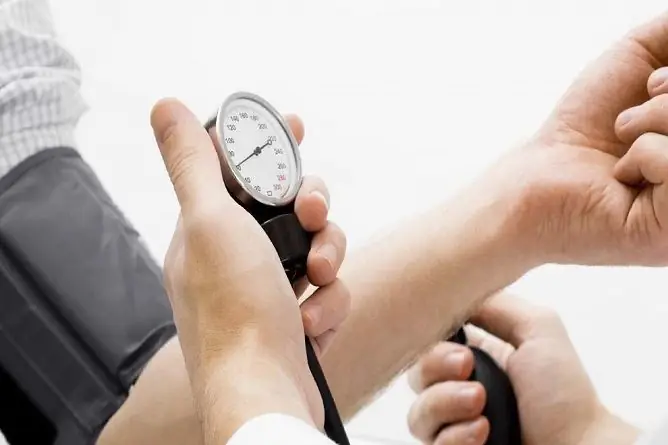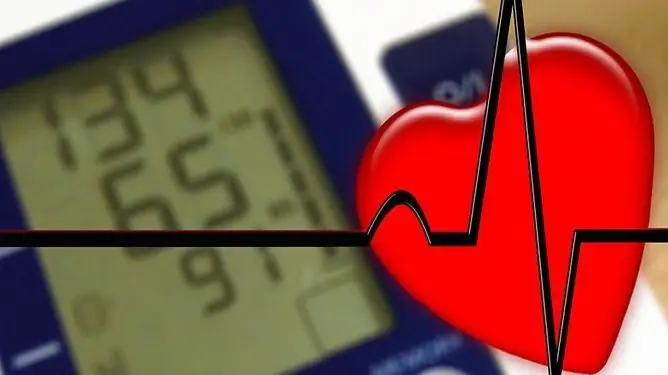- Author Rachel Wainwright [email protected].
- Public 2023-12-15 07:39.
- Last modified 2025-11-02 20:14.
Systolic and diastolic pressure - what are they?
The content of the article:
- Systolic and diastolic blood pressure
- Blood pressure: normal value
- Causes of high and low blood pressure
- What does high and low blood pressure affect?
- Video
What is it, systolic and diastolic pressure? This is the upper and lower indicator of arterial, or blood pressure, that is, the pressure that blood exerts on the walls of the arteries. Blood pressure (BP) is one of the main parameters to assess the state of the vital functions of the human body.

Blood pressure is determined by two indicators - upper (systolic) and lower (diastolic)
Systolic and diastolic blood pressure
Blood pressure depends on the volume of blood that the heart pumps per unit of time and the resistance of the blood vessels. It is written in the form of two numbers, which are separated by a fraction. In this “fraction,” the numerator is the systolic pressure, and the denominator is the diastolic pressure.
Systolic pressure is the pressure that occurs in the vessels at the time of systole, i.e., the release of blood from the heart. It is also called the top. In fact, it shows with what force the myocardium pushes blood from the left ventricle into the arterial vascular system.
Diastolic pressure is the pressure of the blood in the vessels at the time of the heart's diastole (lower blood pressure). This indicator allows you to assess the resistance of peripheral vessels.
The difference between upper and lower pressure is called pulse pressure. Normally, its value is 35-55 mm Hg. Art.
Blood pressure: normal value
BP is a purely individual indicator, which is influenced by many factors. Nevertheless, for people of different ages, average indicators of the norm have been determined. They are presented in the table.
| Age | Women | Men |
| Up to 1 year | 95/65 | 95/66 |
| 1 to 10 years old | 103/70 | 103/69 |
| 10 to 20 years old | 116/72 | 123/76 |
| 20 to 30 years old | 120/75 | 126/79 |
| 30 to 40 years old | 127/80 | 129/81 |
| 40 to 50 years old | 137/84 | 135/83 |
| 50 to 60 years old | 144/85 | 142/85 |
| 60 to 70 years old | 159/85 | 145/82 |
| 70 to 80 years old | 157/83 | 147/82 |
|
Over 80 years old |
150/79 | 145/78 |
Causes of high and low blood pressure
In people under 40, normal blood pressure is 110-120 / 70-80 mm Hg. Art. If blood pressure is below these numbers, then the value is assessed as low. Pressure 121-139 / 81-89 mm Hg. Art. is considered elevated, and 140/90 and above - high, indicating the presence of one or another pathology.
Low blood pressure can be due to the following:
- intense sports;
- living in the highlands;
- work in hot shops;
- a decrease in the volume of circulating blood (massive burns, blood loss);
- cerebral and spinal injuries;
- decreased tone of peripheral blood vessels (septic, anaphylactic shock);
- acute and chronic heart failure;
- sepsis;
- some dysfunctions of the endocrine system.
Low blood pressure is often observed against the background of chronic fatigue, systematic lack of sleep, depression, and is also often found in the early period of pregnancy.
High blood pressure can be due to one of the following reasons:
- renal vascular pathology (atherosclerosis, fibromuscular dysplasia, thrombosis or aneurysm of the renal arteries);
- bilateral kidney damage (polycystic nephritis, interstitial nephritis, diabetic nephropathy, glomerulonephritis);
- unilateral kidney damage (unilateral tuberculosis, hypoplasia, single cyst or kidney tumor, pyelonephritis);
- primary salt retention (Liddle syndrome);
- long-term use of certain medications (corticosteroids, oral contraceptives, ergot alkaloids, cyclosporine);
- endocrine diseases (acromegaly, Itsenko-Cushing's syndrome, pheochromocytoma, congenital adrenal hyperplasia);
- vascular diseases (stenosis of the renal artery, coarctation of the aorta and its large branches);
- OPG-gestosis (late toxicosis of pregnant women);
- neurological diseases (brain tumors, intracranial hypertension, respiratory acidosis).
What does high and low blood pressure affect?
It is often believed that hypotension, in contrast to hypertension, does not pose a danger to human life, because low pressure does not lead to the development of diseases such as myocardial infarction, cerebral stroke. But in fact, hypotension can cause the following conditions:
- worsening of the course of diseases of the cardiovascular, nervous and endocrine systems;
- deterioration in the quality of life (increased fatigue, decreased performance, impaired concentration, drowsiness, muscle weakness);
- sudden fainting;
- decreased potency in men.
With age, people with hypotension develop hypertension. Moreover, even a slight increase in pressure leads to the occurrence of a hypertensive crisis, the treatment of which presents certain difficulties. This is due to the fact that in this situation, even small doses of antihypertensive drugs can lead to a sharp drop in blood pressure, up to the development of collapse and acute cardiovascular failure, which, in turn, can cause death.

It is necessary to regularly measure blood pressure, taking timely measures to correct it
A single high blood pressure does not mean at all that the patient suffers from arterial hypertension. Only if the increased numbers of systolic and diastolic pressure (or one of them) are recorded in at least three control measurements, a diagnosis of hypertension is made and appropriate treatment is prescribed. Without therapy, the disease will progress and can lead to a number of complications:
- atherosclerosis;
- coronary heart disease;
- acute and chronic heart failure;
- acute and chronic disorders of cerebral circulation;
- retinal disinsertion;
- metabolic syndrome;
- chronic renal failure;
- erectile dysfunction.
What treatment is needed for high or low blood pressure? Only a doctor can answer this question after examining the patient. You should not rely on the advice of friends and relatives, because if some drug helps one person well, this does not mean at all that it will be as effective for another.
Video
We offer for viewing a video on the topic of the article.

Elena Minkina Doctor anesthesiologist-resuscitator About the author
Education: graduated from the Tashkent State Medical Institute, specializing in general medicine in 1991. Repeatedly passed refresher courses.
Work experience: anesthesiologist-resuscitator of the city maternity complex, resuscitator of the hemodialysis department.
Found a mistake in the text? Select it and press Ctrl + Enter.






